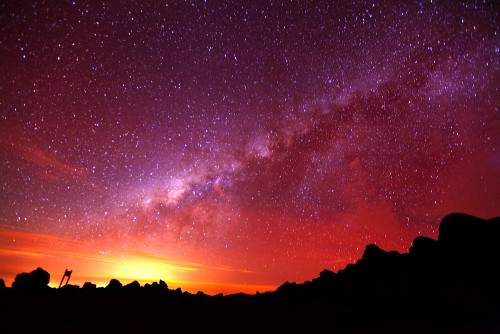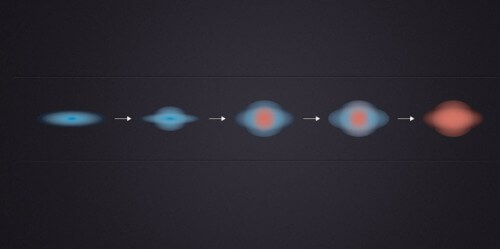"In the early universe, an active galaxy created stars at a high rate for about 1-2 billion years, then undergoes a drastic contraction and dies," says Prof. Avishi Dekel from the Hebrew University in response to a question from the Hidaan site. Prof. Dekel's group is involved in the article appearing today in the journal Science

It turns out that the galaxies in the early universe were very active, and created new stars at a high rate, but at a certain point they stopped the star creation activity, and became "red and dead". At the same time, their shape crystallized into compressed spherical structures of old stars. These are ultimately the cores of today's inactive elliptical galaxies, which contain most of the stars (suns). These processes began to occur more than ten billion years ago, about three billion years after the big bang of the formation of the universe. Understanding the cessation of activity and the creation of the compressed structure are among the fascinating questions facing cosmologists.
In an article published today in the prestigious journal Science, astronomers report on observational discoveries that shed light on the compression and death process of galaxies. The group of researchers includes astronomers from Switzerland and Germany, as well as the cosmology group of the Hebrew University in Jerusalem headed by Prof. Avishai Dekel. The new discoveries confirm the new theoretical understanding that Prof. Deckel and his colleagues are developing based on computer simulations of galaxy formation. According to the fading model, every galaxy goes through a dramatic contraction event during its history, which explains the apparent compression, predicts the early burst of new stars, and the subsequent complete cessation of star formation.
The dramatic event of compression has various causes, such as collisions between galaxies, or between opposing streams of gas that build the galaxy. Following such an event, the hydrogen gas, which is the main component of the galaxies in the early universe, heats up, is compressed to a high density, loses energy and rotation, and collapses under the influence of its own gravity into a compressed core of the galaxy. Dense gas is the "fuel" for rapid star formation. However, it is the burst of star formation itself that ultimately causes star formation to cease. Part of the gas in the core is swallowed by the new stars and the giant black hole in the center of the galaxy, and the other part is blown out of the galaxy by supernova explosions of stars and by strong winds blown from the vicinity of the black hole. At the same time, the fall of fresh gas to the center of the galaxy stops, thus stopping the supply of "fuel" for the formation of new stars. Prof. Dekel and his colleagues describe the physical processes responsible for this sequence of events in an article published these days in the journal of the British Royal Astronomical Society.

The theoretical predictions fit the observations that show that the galaxies in the early universe are indeed significantly compressed. Red, inactive, compact galaxies were first discovered. Recent observations have confirmed that the source of these are blue compact galaxies, which form stars at a high rate. These were discovered using the Hubble Space Telescope, in the CANDELS project in which the cosmology group at the Hebrew University participates. The observational discoveries now reported in Science establish the scenario in question through observations from the Great European Observatory in Chile, which make it possible to refine with high resolution the internal structure of the dense galactic cores in the early universe. The observations identify for the first time galaxies that are in the midst of the so-called process of star formation rallies in the galactic core, while stars are still being formed in the galactic periphery.
In response to the science site's question, is this what is expected of galaxies even today or was it a common phenomenon in the early universe, Prof. Dekel says: "The contraction was a common phenomenon in the early universe. The condition for contraction is that a significant part of the mass is in the gas, not in the stars, because gas can lose energy (by radiation) and compress. This is the case in the early universe, but in today's galaxies the gas makes up less than 10% of the mass.
What is meant by these galaxies most of the suns are found, meaning there are many more dead galaxies than active?
Prof. Dekel: "Most massive galaxies, and most of the mass, are elliptical, red and dead galaxies. There are more spiral galaxies, active, but they are smaller, and therefore contain less than half the stars on average compared to dead galaxies. Today's elliptical galaxies were the active galaxies of the early universe. They were much more active than today's active galaxies."
What happened to the other stars in it? Have the stars come closer? Did many stars escape to other galaxies or did they just end their lives and the biggest ones just exploded in a supernova?
Prof. Dekel: "In the compressed phase, most of the stars are in the compressed core. Only later do new stars form in the surrounding disk.”
What is the average lifespan of an active galaxy?
"In the early universe, an active galaxy creates stars at a high rate for about 1-2 billion years, then undergoes a drastic contraction and dies. An active galaxy in the later stages of the universe lives more than 5 billion years because its activity rate is less.
What might happen during the expected collision between the Milky Way and Andromeda, two huge galaxies with hundreds of billions of stars. Will both contract after a massive burst of star formation as a result of interstellar gas condensation?
"The Milky Way and Andromeda are both galaxies with star-forming activity, but low (about one sun per year). They only have a little gas. Therefore the result of the collision will be much less dramatic. They will transform into a spherical galaxy, but without overall contraction. As mentioned, in order to contract, the galaxies must be built mainly of gas, which is dissipative - it can lose energy after the creation of shock waves in a collision."
According to the researchers, the attempt to understand the formation of galaxies is the most active field in modern research in cosmology, on the way to understanding the connection between the universe and the development of life in it. The combination of observations from space and huge telescopes on Earth, and advanced supercomputer simulations of the formation of galaxies in the universe, lead step by step to an understanding of the formation of galaxies. This is a major milestone in the cosmic process that began with the Big Bang, passed through the formation of the cosmic fabric and in it the galaxies, the formation of stars (suns) within, the formation of planets around them, and ultimately the development of life on the planets.
The research activity of the Center for Astrophysics and Planetary Sciences of the Hebrew University takes place within the framework of the National Center of Excellence (ICORE) "Genesis: From the Big Bang to the Formation of Life".
More of the topic in Hayadan:
- Imaging proved: the moon was formed from material that was blown off the earth when a large body collided with it
- Complex organic molecules, the basis of life, were discovered in the disk of a nascent solar system
- A huge cluster of galaxies was discovered
- The first detailed simulation of the universe
.

5 תגובות
Following on from Moshe's response, I would like to refine the explanation that the universe accelerates as a result of sucking mass into black holes. Is there a match between the rate of suction (which is increasing) and the rate of acceleration of expansion?
Moses
This explanation is not new. It existed a hundred years ago and was disproved by showing that more distant bodies appear younger to us. One of the famous supporters of this theory is the famous Fred Hoyle, who coined the phrase "the big bang".
Hello to my father Blizovsky
I have an opinion (please write it down now, because in a few years it will be adjusted) that the universe is dynamic and constantly forming, the black holes suck into them, as we know for sure everything in their surroundings and emit new galaxies all the time, therefore it seems to us that the universe is expanding all the time
Quite interesting